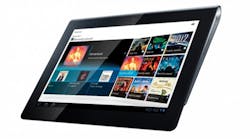Tablet and smartphone demand remains strong, particularly as price reductions attract new consumers. Beyond the expanding competition for tablets, “phablets” and smartphones, 2013 International CES revealed how the feature envelope is being pushed to both unify and expand users' mobile experiences.
From the inside out
Front and center are the next generation of component capabilities for consumer electronics. Qualcomm's opening keynote underscored that the components in today's devices are not only competitive differentiators, but provide innovative solutions to the demand for full device integration. From an industry perspective, the hardware-software interaction is becoming more embedded in device design to meet users' demands today and drive new ways for using devices.
One important benefit of new component architectures is power efficiency, realized from the 2x-nanometer scale as well as increased system-on-chip (SoC) designs. Additionally, we see more hybrid processors that are integrating capabilities at the component level, rather than from within an application on demand. Beyond power efficiency, the gains include faster response time (also thanks to new processors), improved graphic resolution and refresh cycles, plus new capabilities from integrated sensor hubs. Notably, there were many examples at CES of increased capabilities for devices connecting via wireless sensors over the latest 802.11ac WiFi standard and Bluetooth. Perhaps the most prolific merging of sensors, power management, and wireless chips is the wireless charging that seems to be sweeping CES this year.
Embedded capabilities
Chip manufacturers are touting core improvements in speed, density, efficiency, power management, and interoperability, with new design focus on the mobile sector (for example, tablets, smartphones, and ultrabooks). CES announcements came from Intel, AMD and ARM, respectively, improving their processors while targeting mobile to achieve richer experiences. Broadcom similarly showcased chip advances that integrate user experiences across wired and wireless devices to move us closer to a "connected life" through the seamless interoperability of users’ mobile devices (smartphones and tablets) to interact with cars, TVs, and home systems (alarm, thermostat, and so on).
In the home, Ultra HD, or 4k TVs, with extremely crisp and beautiful imagery were CES headliners. With the TV market in need of a fresh driver, once prices drop, this next-gen home theater could well be the answer. Again, this image delivery is directly tied to component developments that deliver this content. Embedded chip companies, such as Broadcom, have already begun providing solutions for content delivery for Ultra HD TV sets, such as broadband chipsets and means to upgrade Blu-ray players and discs to deliver this data-heavy content.
In the health and automotive markets, the advantages to more device interactivity are propelling growth. Remote patient care, monitoring, drug delivery, and real-time non-emergency counseling are made possible through advanced sensors and wireless chips at cost levels that dramatically increase accessibility in both rural and urban areas. Automotive, safety and fuel-efficiency features are growing, meaning that while drivers may have more distractions, the improvements in LIDAR (light detection and ranging) for autonomous driving and driver-assisted capabilities are addressing these real concerns and providing solutions—whether through monitoring eye movement and shutting down distractions or assisting in the driving itself.
Demand drivers abound
The next generation of devices is clearly based on the components that make up existing devices. CES is a sensory overload for those on the ground, and sensory integration is exactly where the advances are based on the innovative architectures that are supporting an entirely new array of capabilities from the devices we are really only just beginning to master.









